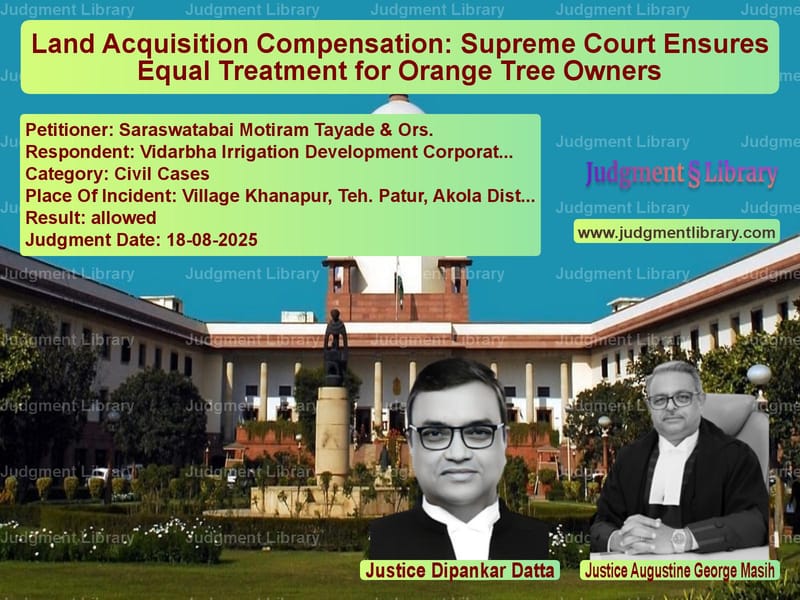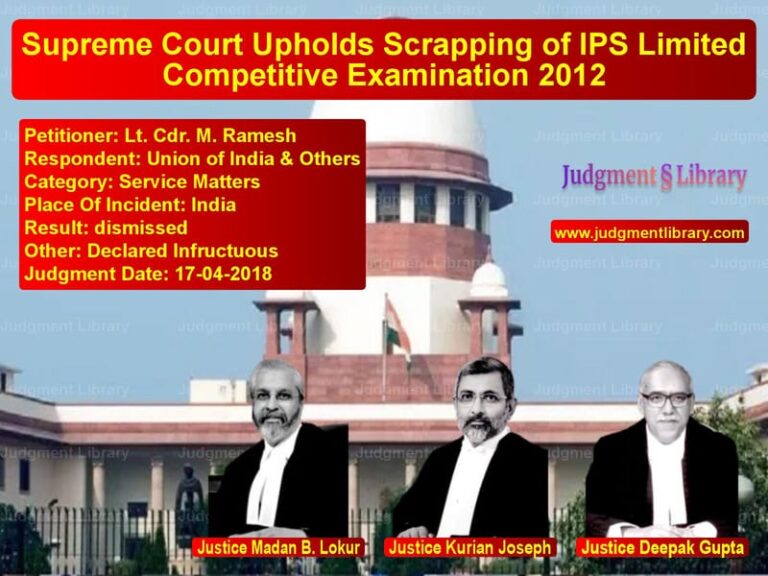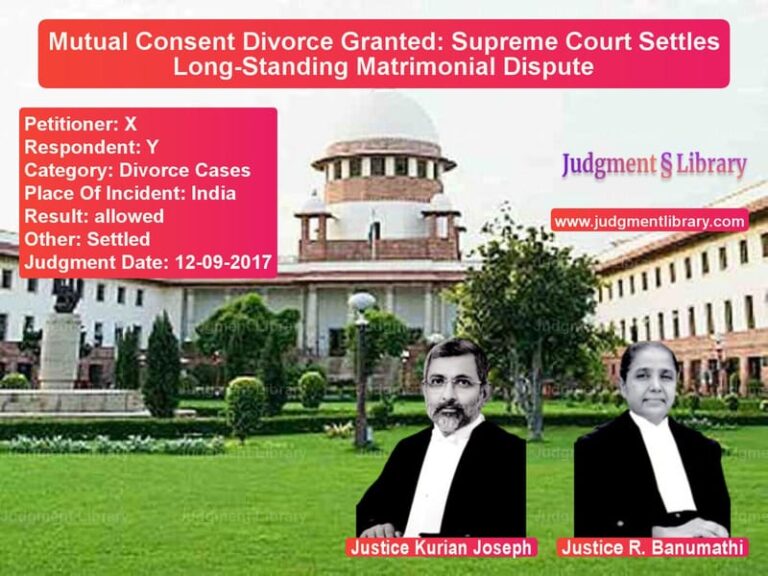Land Acquisition Compensation: Supreme Court Ensures Equal Treatment for Orange Tree Owners
In a significant judgment that underscores the importance of equal treatment in compensation matters, the Supreme Court of India has restored higher compensation for orange tree owners whose lands were acquired for an irrigation project in Maharashtra. The case, which revolved around the appropriate multiplier to be applied for calculating compensation for fruit-bearing trees, highlights the crucial principle that similarly situated landowners must receive equal treatment under the law, particularly when their properties are acquired under the same acquisition notification.
The legal battle began when the Vidarbha Irrigation Development Corporation acquired large tracts of land in village Khanapur, Teh. Patur, in the Akola district, pursuant to a notification dated August 22, 1995, issued under Section 4 of the Land Acquisition Act, 1894. The appellants, Saraswatabai Motiram Tayade and others, were among the landowners affected by this acquisition. Like many others, they sought a reference before the appropriate court under Section 18 of the Land Acquisition Act, challenging the adequacy of the compensation offered for their acquired properties, which included 42 orange trees along with other valuable trees.
The Compensation Dispute
The reference court, in its award dated August 29, 2011, had awarded Rs. 3,15,000 for the 42 orange trees, applying a multiplier of 15 years’ purchase. This calculation was based on expert evidence presented during the proceedings. However, when the matter reached the Bombay High Court, the multiplier was reduced from 15 to 10, following precedents set in Bilquis v. State of Maharashtra and Revenue Divisional Officer, Kurnool District v. M. Ramakrishna Reddy. This reduction decreased the compensation for the orange trees from Rs. 3,15,000 to Rs. 2,10,000 – a significant reduction of Rs. 1,05,000 that prompted the landowners to approach the Supreme Court.
Examining the Legal Precedents
The Supreme Court carefully examined the two precedents that had influenced the High Court’s decision. Regarding the Bilquis case, the Court noted that “the observation that the reference court ought to have used the 10 years purchase as a multiplier instead adopting 20 years purchase was rendered ‘in the facts and circumstances of the case’. This decision, therefore, is not a precedent on the aspect of multiplier which would be binding on all courts in terms of Article 141 of the Constitution.”
Similarly, while analyzing the M. Ramakrishna Reddy case, the Court observed that “this Court observed that the general trend is to adopt a multiplier of 8 to 10 in regard to plantations, fruit orchards, and the multiplier ranging from 10 to 12 for agricultural crop land. It was also observed that in the absence of any special circumstances to apply the higher multiplier of 12 or 13 or the lower multiplier of 8, the standard multiplier of 10 should be applied having regard to the evidence in regard to the nature, standard and position of the orchard.” Importantly, the Court emphasized that “Even this decision acknowledges that if there exist special circumstances, application of a higher or a lower multiplier could be justified.”
The Crucial Evidence and Special Circumstances
The Supreme Court found that there were indeed special circumstances in the present case that justified the application of a higher multiplier. During the reference proceedings, evidence had been tendered by an expert from a local agricultural university who testified that “the life of an orange tree could be up to 30 years. The periodical yield of an orange tree from time to time was further spoken to by him. According to him, an orange tree could bear fruits for 15 to 20 years.” This expert evidence provided a solid foundation for the reference court’s decision to apply a multiplier of 15.
Furthermore, the Court noted that “There was evidence before the reference court that the orange trees of the appellants were 3 to 4 years old. Having regard to the evidence of the expert, application of the multiplier of 15 appears to be a plausible approach.”
The Principle of Equal Treatment
The most compelling aspect of the case emerged when the Supreme Court discovered that other landowners whose properties were acquired under the same notification had received compensation based on a multiplier of 15 for their orange trees. The Court noted that “In respect of the orange trees standing on such adjacent lands, the reference court had adopted 15 years’ purchase and applied the multiplier of 15 while computing compensation.” One such award had been challenged before the High Court in First Appeal No. 627 of 2013 and was affirmed vide judgment and order dated November 27, 2019.
The Supreme Court expressed strong disapproval of the discriminatory treatment, stating that “what emerges is this that for acquisition of lands under a common notification issued under Section 4 of the L A Act in respect of lands comprised in one village, the multiplier applied for determining compensation for uprooted orange trees of other landowners is 15 whereas it is 10 for the appellants.”
The Court firmly declared that “We do not think that in the matter of grant of compensation, landowners who are similarly situate should face any kind of discrimination.” This principle of equal treatment formed the cornerstone of the Court’s decision.
The Court’s Final Ruling
In its conclusive analysis, the Supreme Court held that “Once the respondent has accepted the judgment and order dated 27th November, 2019, the notice of the learned Judge was not invited to such judgment and order and there being no tenable reason assigned for reduction of the multiplier from 15 to 10, we are of the considered opinion that the said judgment and order dated 27th November, 2019, constituted a special circumstance for which multiplier of 15 applied by the reference court should not have been disturbed.”
The Court accordingly allowed the appeal and directed that “determination of the reference court qua compensation for the 42 orange trees should be restored and that of the High Court set aside.” The respondents were directed to “pay, within 8 weeks, the balance sum of Rs. 1,05,000/- to the appellants together with interest at the rate of 6% per annum from 17th September, 2020 till payment is made. In default, rate of interest shall increase to 9% per annum.”
This judgment serves as an important reminder of the fundamental principle that equality before the law is not merely a constitutional guarantee but a practical requirement in the administration of justice. The Supreme Court’s decision ensures that landowners facing acquisition proceedings receive fair and equal treatment, particularly when their circumstances are identical to others who have already received favorable determinations. The ruling also emphasizes that while general principles and precedents provide guidance, courts must consider the specific facts and evidence in each case, especially when special circumstances warrant deviation from standard practices.
Petitioner Name: Saraswatabai Motiram Tayade & Ors..Respondent Name: Vidarbha Irrigation Development Corporation & Anr..Judgment By: Justice Dipankar Datta, Justice Augustine George Masih.Place Of Incident: Village Khanapur, Teh. Patur, Akola District, Maharashtra.Judgment Date: 18-08-2025.Result: allowed.
Don’t miss out on the full details! Download the complete judgment in PDF format below and gain valuable insights instantly!
Download Judgment: saraswatabai-motiram-vs-vidarbha-irrigation-supreme-court-of-india-judgment-dated-18-08-2025.pdf
Directly Download Judgment: Directly download this Judgment
See all petitions in Property Disputes
See all petitions in Damages and Compensation
See all petitions in Judgment by Dipankar Datta
See all petitions in Judgment by Augustine George Masih
See all petitions in allowed
See all petitions in supreme court of India judgments August 2025
See all petitions in 2025 judgments
See all posts in Civil Cases Category
See all allowed petitions in Civil Cases Category
See all Dismissed petitions in Civil Cases Category
See all partially allowed petitions in Civil Cases Category







